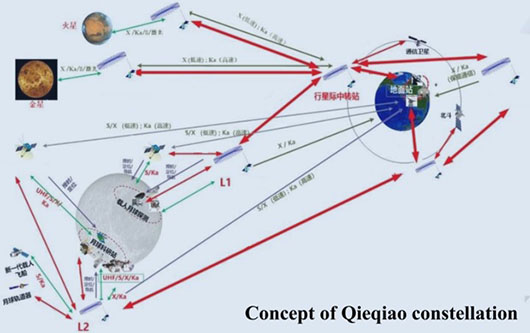Special to CosmicTribune.com, June 21, 2023
By Richard Fisher
China is advancing two architectures it could employ to increase its control of the Moon.
ILRSCO
First, China is announcing early members of its International Lunar Research Station Cooperation Organization (ILRSCO). It was first announced in April at a conference in Hefei of the China Deep Space Exploration Laboratory (DSEL), by its director and the “chief designer” of China’s lunar exploration program, Wu Weiren.

ILRSCO is a formal organization of member countries to be led by China, with a secretariat funded by China and based in China, to allow Beijing to exercise leadership over a lunar coalition that will likely fully support China’s actions and ambitions for the Moon.
But China is previewing its membership before a formal ceremony to start the organization later this year.
On June 14 the historically pro-China government Hong Kong newspaper Ta Kung Pao reported:
“Russia, Pakistan, the United Arab Emirates and the Asia-Pacific Space Cooperation Organization have signed contracts to join [the ILRSCO], and more than ten countries and organizations are negotiating agreements.”
The China-led, Beijing-headquartered Asia Pacific Space Cooperation Organization (APSCO) includes Bangladesh, China, Iran, Mongolia, Pakistan, Peru, and Thailand, with Turkey and Indonesia having signed the APSCO convention.
During a May 30 visit to DSEL, Amo Nadim, chairman of the Pakistan Space and Upper Atmosphere Research Commission (SUPARCO). In a DSEL report on the Weixin social media page, Wu Weiren said:
“China welcomes Pakistan’s full participation in the large scientific project of the International Lunar Research Station and its close cooperation with the Deep Space Exploration Laboratory, setting an example for promoting the building of a community with a shared future for mankind in outer space.”
China has already launched one communication satellite and two remote sensing satellites for Pakistan and has engaged in discussions about Pakistani astronauts visiting the Chinese Space Station, so extending cooperation to include Pakistani participation in the ILRS is a logical follow on.
SUPARCO has also developed many Pakistani solid fuel ballistic missiles with China’s assistance.
Pakistan’s participation in China’s Space Station, Moon and likely Mars programs was likely strengthened by the June 14 announcement that China and Pakistan will form a “strategic partnership,” usually for China symbolizing all but an “alliance.”
In April Venezuela stated its interest in joining the ILRS.
Then on June 17 the Chinese Sina web page reported that Azril Kamil Napiah, director of the Malaysian National Space Agency, stating that Malaysia would also like to join the ILRS.
Napiah said, “We are happy to join, but would like to discuss the details of what role we will play in the project,” and he added that Malaysia did not want to just be a “passenger.”
Queqiao satellite constellation
Previously on June 15 English-language propaganda show “Youth n Tech” on the Chinese BiliBili.com webpage, Dr. Low Jing Xiang, a Malaysian associate at China’s University of Science and Technology, made an announcement regarding a second Chinese Moon control architecture.
Low stated, “…China has agreed to requests from NASA [United States Aeronautical and Space Administration] and other space agencies from other countries for helping their Moon missions in the future,” by allowing access to China’s Queqiao satellite constellation that will service the Moon, Mars and beyond.
Full Text . . . . Current Edition . . . . Subscription Information

You must be logged in to post a comment Login